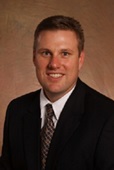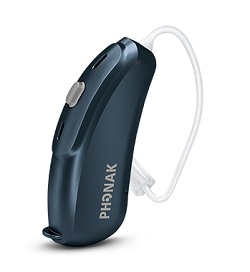Introducing Phonak CROS II, Designed for Better Performance in Noise
Carolyn Smaka: Bill, what makes Phonak’s CROS II unique?

Bill Dickinson: It’s exciting that our CROS II solution is now available on the Venture platform. This launch has enabled us to overcome many patient challenges experienced with older CROS products. Phonak CROS II incorporates all of the best features of the Venture platform. It is fully automatic and powered by the new environmental classification system AutoSense OS, as well as fully integrated Binaural VoiceStream Technology™ with four-microphone sampling, providing the adaptive null and narrow beam of StereoZoom.
Historically, CROS products have been omnidirectional. Typically, they provided good sound awareness for the poorer hearing side, and some help with localization and lateralization. However, the benefits of this audibility were often lost in noisy situations where people with unilateral hearing losses have the most problems. In quiet situations, people may be able to somewhat compensate for the poorer hearing side with workarounds, whether unaided or aided with hearing technology.
We know that as noise increases, the omnidirectional signal sent from the transmitter to the receiver side may decrease speech understanding performance in the better hearing ear because of the omnidirectional input. Clinically, audiologists would often have to program specific settings in the CROS system to reduce or remove the omnidirectional influence or even counsel their patients to take out the transmitter side when in these noisy situations. While each workaround could be effective for end user, neither solution is ideal as it requires a manual decision-making process from the patient.
 With Phonak CROS II, we’re able to provide full streaming of audio signals from the poorer hearing side to the better hearing side, and now the CROS patient can enjoy all the benefits of StereoZoom, which has been clinically proven to improve speech understanding in loud noisy situations. In the CROS II validation studies, we saw that it performed significantly better in noise than the previous CROS I platform and demonstrated improved performance compared to any competitive wireless CROS product in the market today.
With Phonak CROS II, we’re able to provide full streaming of audio signals from the poorer hearing side to the better hearing side, and now the CROS patient can enjoy all the benefits of StereoZoom, which has been clinically proven to improve speech understanding in loud noisy situations. In the CROS II validation studies, we saw that it performed significantly better in noise than the previous CROS I platform and demonstrated improved performance compared to any competitive wireless CROS product in the market today.
For the first time, we have a product that effectively manages noise for our patients with single-sided deafness (SSD) and asymmetrical hearing loss. Earlier Phonak CROS focused on providing sound identification, sound awareness, and lateralization. With this next generation product, we have a proven and seamless solution in noise – exactly where patients need it the most.
Carolyn: What styles are available in CROS II?
Bill: CROS II is available in 312 and 13 models using Audéo V housings. It is compatible with all Bolero V (BTE) and with all Audéo V (RIC) hearing aids, and comes in 11 color options.
Carolyn: What about battery consumption?
Bill: Phonak CROS II consumes up to 30% less battery than the previous CROS generation, which is another great benefit of the Venture platform. While the previous CROS was a great advancement in the streaming of sound input from the poorer side, it was accomplished using a comparatively high battery consumption. A great example of Phonak innovation is the ability to have a significantly more powerful DSP chip with the Venture platform, while simultaneously providing wearers 30% more battery life.
Carolyn: What do audiologists need to know about fitting CROS II?
Bill: From a clinical standpoint, it’s a considerably easier protocol to fit the CROS II. For me, one of the most meaningful changes is the ability to keep the CROS II transmitter active throughout the fitting process. That streamlines and simplifies the process for the clinician, but more importantly, it allows the patient to be an active participant in the fitting process by providing real-time feedback to the clinician. This benefit allows the audiologist to better meet the needs and expectations of the patient during the entire fitting process.
Carolyn: Does the CROS II have remote capabilities with the smartphone app? We know that CROS users sometimes want manual control of their devices.
Bill: Yes, although CROS II functionality is fully automatic with AutoSense OS in the premium V90 level, the CROS II system integrates remote connectivity with all smartphones. Currently, both Android and Apple devices can connect directly to the hearing receiver side only, while in the near future the remote function will include both receiver and transmitter side capabilities.
Carolyn: What is the difference between the performance levels?
Bill: The performance of Phonak CROS II improves with the performance level of the hearing aid it is fitted with. If you combine it with the V90, you’ll get full AutoSense OS capabilities including StereoZoom as an automatic program. With V70, StereoZoom is available in a manual program. With the V50 and V30 levels, you have directionality with UltraZoom on the hearing instrument side, and the signal from the CROS transmitter will be Real Ear Sound or omnidirectional. The advancement of the adaptive null and narrow band directionality of StereoZoom is available if used with the V90 and V70 levels.
Carolyn: I know the CROS II was just released, but what has the feedback been at this early stage?
Bill: It’s interesting because we just completed our customer trainings where we introduced the product. Before I introduced CROS II at the trainings, I asked people their typical experience with other CROS fittings. In general, we know, this is a more challenging patient population for a plethora of medical and audiological reasons. Depending on the listening situation, the hearing handicap can go from minimal to maximal handicap in a matter of seconds. Historically, audiologists acknowledge they have higher return for credit rates with this population and challenges with patient satisfaction or perceived return on investment.
These challenges illustrate the difference between hearing aid efficacy vs. hearing aid effectiveness. The efficacy of the current CROS platform has been very high, specifically the product delivers input from the poorer side. However, from a product effectiveness standpoint, it was often a mixed report. In quiet, the effectiveness of traditional CROS was good, but effective outcomes were challenged greatly in noise.
Venture CROS II finally gives both the provider and patient a well-proven tool to overcome the difficulty of listening in noise. Everyone in the audiology community has been waiting for a CROS product to do just that, and now CROS II is here. Professionals are very excited to have this solution available to benefit their patients and most important, this technology innovation is already making a truly meaningful difference in the lives of patients.
Carolyn: Thanks for the overview. Readers can also watch the Video Spotlight that provides a patient’s experience and perspective with CROS II. Best wishes for continued success with the new release.
Learn more on the Phonak Expo Page on AudiologyOnline.


